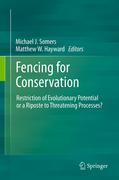
Fencing for conservation: restriction of evolutionary potential or a riposte to threatening processes?
Somers, Michael J.
Hayward, Matthew
The conflict between increasing human population and biodiversity conservation is one of the IUCN’s key threatening processes. Conservation planning has received a great deal of coverage and research as a way of conserving biodiversity yet, while theoretically successful, it has never been tested. Simple lineson maps to illustrate conservation areas are unlikely to be successful in thelight of human encroachment. It may be that some form of overt display is necessary to ensure the protection of reserves. This may be signage, presence of guards/rangers or physical fencing structures. The need for some form of barrier goes beyond restricting human access. The megafauna of Africa pose a genuine threat to human survival. In southern Africa, fences keep animals in and protect the abutting human population. Elsewhere, fencing is not considered important or viable. Where poverty is rife, it won’t take much to tip the balance from beneficial conservation areas to troublesome repositories of crop-raiders,diseases and killers. Conversely, in New Zealand fences are used to keep animals out. Introduced species have decimated New Zealand’s endemic birds, reptiles and invertebrates, and several sites have been entirely encapsulated in mouse-proof fencing to ensure their protection. Australia faces the same problemsas New Zealand, however surrounds its national parks with cattle fences. Foxes and cats are free to enter and leave at will, resulting in rapid recolonisation following poisoning campaigns. How long will these poison campaigns work before tolerance, aversion or resistance evolves in the introduced predator populations? An evaluation of the positives and negatives of fencing in conservation and wildlife management. Includes case studies from around the world. This book will look at the positives and negatives of fencing. INDICE: Chapter 1.An introduction to fencing for conservation. Matt W. Hayward and Michael J. Somers. Chapter 2. Perspectives on fencing for conservation based on four case studies: marsupial conservation in Australian forests; bushmeat hunting in South Africa; large predator reintroduction in South Africa;and large mammal conservation in Poland. Matt W. Hayward. Chapter 3. The relative merits of predator-exclusion fencing and repeated fox baiting for protection of native fauna: five case studies from Western Australia. Paul J. de Tores and Nicky Marlow. Chapter 4. Fences or ferals? Benefits and costs of conservation fencing in Australia. Chris R. Dickman. Chapter 5. The use and potentialof pest-proof fencing for ecosystem restoration and fauna conservation in NewZealand. Bruce Burns , John Innes and Tim Day. Chapter 6. Fencing for purpose: A case study of elephants in South Africa. Rob Slotow. Chapter 7. An adaptive monitoring programme for studying impacts along the western boundary fence of Kruger National Park, South Africa. Ken Ferguson, Laura Adam and Ferran Jori. Chapter 8. Does the vastness of the Serengeti limit human-wildlife conflicts? Marion L. East, Julius W. Nyahongo, Katja V. Goller and Heribert Hofer. Chapter 9. Barriers, the beef industry and unnatural selection: a review of the impacts of veterinary fencing on mammals in southern Africa. Michelle E. Gadd. Chapter 10 Modelling the effect of fences on the viability of spatially structured populations of African wild dogs. Michael J. Somers , Markus Gusset and Fredrik Dalerum. Chapter 11. Towards a true ecology: exploring the implications for conservation of the human and social dimensions of fencing in the subtropical thicket biome, South Africa. Andrew T. Knight and Richard M. Cowling. Chapter 12. Ecological, social and financial issues related to fencing as a conservation tool in Africa. Peter A. Lindsey, Chap L. Masterson, Andrew L. Beck andStephanie Romañach. Chapter 13. Do fences or humans inhibit the movements of large mammals in Bia?owie?a Primeval Forest? R. Kowalczyk , K. Schmidt and W J?drzejewski . Chapter 14. Exploring the value of wolves ( Canis lupus ) in landscape-scale fenced reserves for ecological restoration in the Scottish Highlands. Christopher Sandom, Joseph Bull, Susan Canney and David W. Macdonald. Chapter 15. The influence of land use and fences on habitat effectiveness, movements and distribution of pronghorn in grasslands of North America C. Cormack Gates Paul Jones, Michael Suitor, Andrew Jakes, Mark S. Boyce and Kyran Kunkel- Chapter 16. Use of electric fencing and associated measures as deterrents to jaguar predation on cattle in the pantanal of Brazil. Sandra M.C. Cavalcanti, Peter G. Crawshaw Jr. and Fernando R. Tortato.
- ISBN: 978-1-4614-0901-4
- Editorial: Springer New York
- Encuadernacion: Cartoné
- Páginas: 366
- Fecha Publicación: 28/12/2011
- Nº Volúmenes: 1
- Idioma: Inglés
